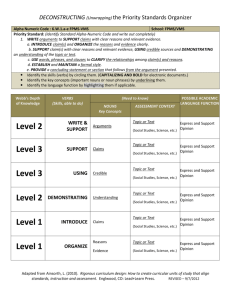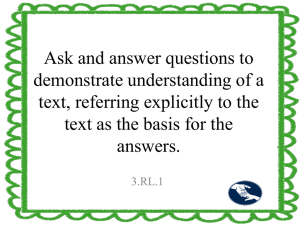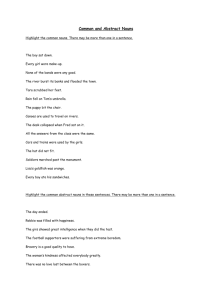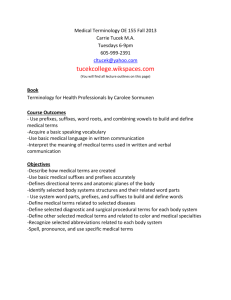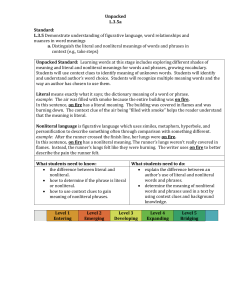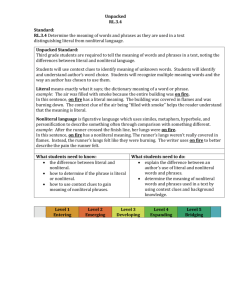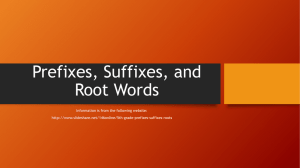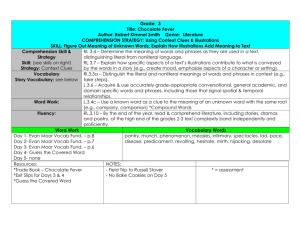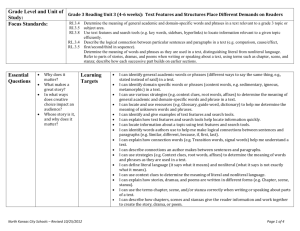Unit 2 - Livingston County School District
advertisement
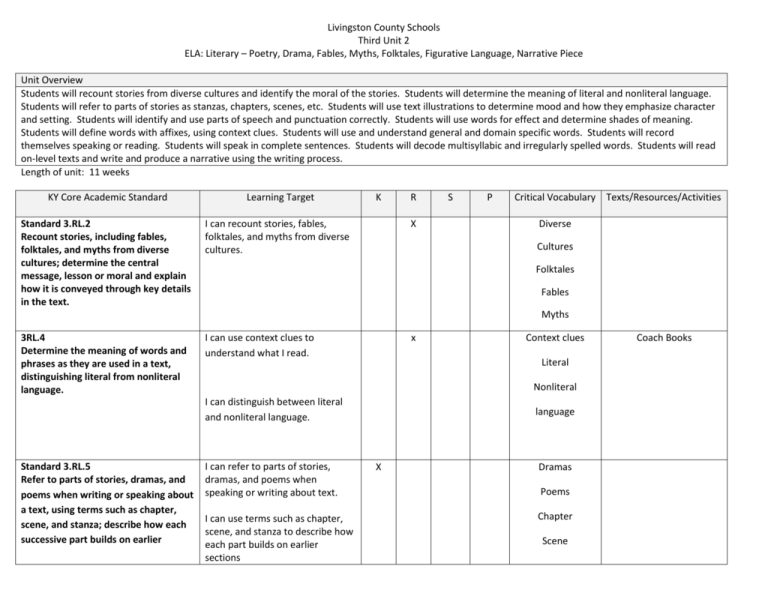
Livingston County Schools Third Unit 2 ELA: Literary – Poetry, Drama, Fables, Myths, Folktales, Figurative Language, Narrative Piece Unit Overview Students will recount stories from diverse cultures and identify the moral of the stories. Students will determine the meaning of literal and nonliteral language. Students will refer to parts of stories as stanzas, chapters, scenes, etc. Students will use text illustrations to determine mood and how they emphasize character and setting. Students will identify and use parts of speech and punctuation correctly. Students will use words for effect and determine shades of meaning. Students will define words with affixes, using context clues. Students will use and understand general and domain specific words. Students will record themselves speaking or reading. Students will speak in complete sentences. Students will decode multisyllabic and irregularly spelled words. Students will read on-level texts and write and produce a narrative using the writing process. Length of unit: 11 weeks KY Core Academic Standard Standard 3.RL.2 Recount stories, including fables, folktales, and myths from diverse cultures; determine the central message, lesson or moral and explain how it is conveyed through key details in the text. Learning Target K I can recount stories, fables, folktales, and myths from diverse cultures. R X S P Critical Vocabulary Texts/Resources/Activities Diverse Cultures Folktales Fables Myths 3RL.4 Determine the meaning of words and phrases as they are used in a text, distinguishing literal from nonliteral language. I can use context clues to understand what I read. x Literal Nonliteral I can distinguish between literal and nonliteral language. Standard 3.RL.5 Refer to parts of stories, dramas, and poems when writing or speaking about a text, using terms such as chapter, scene, and stanza; describe how each successive part builds on earlier Context clues I can refer to parts of stories, dramas, and poems when speaking or writing about text. I can use terms such as chapter, scene, and stanza to describe how each part builds on earlier sections language X Dramas Poems Chapter Scene Coach Books sections. Stanza Standard 3.RL.7 Explain how specific aspects of a text’s illustrations contribute to what is conveyed by the words in a story (e.g., create mood, emphasize aspects of a character or setting). I can identify specific aspects of a text’s illustrations. 3.RL.10 By the end of the year, read and comprehend literature, including stories, dramas, and poetry at the high end of the grades 2-3 text complexity band independently and proficiently. I Can: Identify/understand in literary text: key ideas and details craft and structure integration of knowledge and ideas X Illustrations Mood I can recognize the mood of a story. X at appropriate complexity (Qualitative, Quantitative, and Readers and Task) as seen in 1- 9. 3.L.1a, b, c, d, e, f, g, h, i Demonstrate command of the conventions of standard English grammar and usage when writing or speaking. a. Explain the function of nouns, pronouns, verbs, adjectives, and adverbs in general and their functions in particular sentences. b. Form and use regular and irregular plural nouns. c. Use abstract nouns (e.g., childhood). d. Form and use regular and irregular verbs. e. Form and use the simple (e.g., I walked; I walk; I will walk) verb tenses. f. Ensure subject-verb and pronoun- I can: -Identify abstract nouns X Nouns Verbs -Recognize verb tenses -Identify agreement of: subject-verb pronoun-antecedent -Identify comparative and superlative adjectives and adverbs -Recognize coordinating and subordinating conjunctions -Recognize complex sentences Pronouns Adjectives Adverbs Regular nouns Irregular nouns Plural nouns Abstract nouns antecedent agreement. g. Form and use comparative and superlative adjectives and adverbs, and choose between them depending on what is to be modified. h. Use coordinating and subordinating conjunctions. i. Produce simple, compound, and complex sentences. Regular verbs Irregular verbs Simple verb tenses Antecedent Simple sentence Compound sentence Complex sentence 3.L.2a, b, c, d, e, f Demonstrate command of the conventions of standard English capitalization, punctuation, and spelling when writing. a. Capitalize appropriate words in titles. b. Use commas in addresses. c. Use commas and quotation marks in dialogue. d. Form and use possessives. e. Use conventional spelling for high frequency and other studied words and for adding suffixes to base words (e.g. sitting, smiled, cries, happiness). f. Use spelling patterns and generalizations (e.g. word families, position-based spellings, syllable patterns, ending rules, meaningful word parts) in writing words. I can: -Apply correct capitalization, punctuation, and spelling when writing -Capitalize appropriate words in titles -Use commas in addresses 3.L.3a, b Use knowledge of language and its I can choose words and phrases for effect in my writing, speaking, X Capitalization Text book Titles (Reading and English) Drop in a bucket -Use commas and quotation marks in dialogue -Form and use possessives -Use conventional spelling for high frequency and other studied words and for adding suffixes to base words (e.g., sitting, smiled, cries, happiness) -Use spelling patterns and generalizations (e.g., word families, position-based spellings, syllable patterns, ending rules, meaningful word parts) in writing words x conventions when writing, speaking, reading, or listening. a. Choose words and phrases for effect. b. Recognize and observe differences between the conventions of spoken and written standard English. 3.L.4a , b, c Determine or clarify the meaning of unknown and multiple-meaning words and phrases based on grade 3 reading and content, choosing flexibly from a range of strategies. a.Use sentence-level context as a clue to the meaning of a word or phrase. b.Determine the meaning of the new word formed when a known affix is added to a known word (e.g., agreeable/disagreeable, comfortable/uncomfortable, care/careless, heat/preheat). c. Use a known root word as a clue to the meaning of an unknown word with the same root (e.g., company, companion). 3.L.5a, b, c Demonstrate understanding of word relationships and nuances in word meanings. a. Distinguish the literal and non-literal meanings of words and phrases in context (e.g., take steps). b. Identify real-life connections between words and their use (e.g. describe people who are friendly or helpful). c. Distinguish shades of meaning among related words that describe states of mind or degrees of certainty (e.g. knew, believed, suspected, heard, or reading I can recognize that context clues can help determine the meaning of unknown or multiple-meaning words X X X X I can determine the meaning of a new word when a known prefix or suffix is added to it. I can use a known root word as a clue to the meaning of an unknown word with the same root (e.g., company, companion). I can distinguish the literal and non-literal meanings of words and phrases in context. I can identify real-life connections between words and their use. (e.g. describe people who are friendly or helpful) I can distinguish shades of meaning among related words that describe states of mind or degrees of certainty. Context clues Root words affixes wondered). (e.g. new, believed, suspected, heard, wondered) 3.L.6 Standard: Acquire and use accurately grade-appropriate conversational, general academic, and domain-specific words and phrases, including those that signal spatial and temporal relationships. (e.g., after dinner that night we went looking for them). 3.SL.5 I can use words or phrases when I speak that signal spatial and temporal relationships Create engaging audio recordings of stories or poems that demonstrate fluid reading at an understandable pace; add visual displays when appropriate to emphasize or enhance certain facts or details. Standard 3.SL.6 Speak in complete sentences when appropriate to task and situation in order to provide requested detail or clarification. (See grade 3 Language standards 1 and 3 for specific expectations.) I can recognize “engaging” audio recordings. X I can identify: fluid reading facts or details I can recognize complete sentences in writing and when spoken. X Audience Task Situation I can identify the audience. I can recognize task and situation. (The underpinning knowledge targets are found in Language Standards 1 and 3) 3.F.3a,b, c, d Know and apply grade level-level phonics and word analysis skills in X Prefixes Know and apply grade level phonics and word analysis skills in decoding words. a. Identify and know the meaning of the most common prefixes and derivational suffixes. b. Decode words with common Latin suffixes. c. Decode multisyllabic words. d. Read grade-appropriate irregularly spelled words. decoding words Suffixes I Can: Identify and know: the meaning of the common prefixes meaning of the most common derivational suffixes Decode words with common Latin suffixes . Identify syllables in words. Read multiple syllable words. Recognize irregularly spelled words. 3.F.4a, b, c Read with sufficient accuracy and fluency to support comprehension. a. Read on-level text with purpose and understanding. b. Read on-level prose and poetry orally with accuracy, appropriate rate, and expression on successive readings. c. Use context to confirm or selfcorrect word recognition and understanding, rereading as necessary. I Can: X -read text with purpose and understanding. -read poetry orally with accuracy and expression. Accuracy Coach Book Expression Shel Silverstein Poems Context Clues Reading Text Book Poetry Super Teacher Website Strategy -recognize when to reread text as a self correcting strategy. -use context clues to confirm or self correct word recognition. 3.W.3a-d Write narratives to develop real or imagined experiences or events using effective technique, descriptive details, and clear event sequences. a. Establish a situation and introduce a narrator and/or characters; organize an event sequence that unfolds naturally. I can: *Write a narrative that includes characters and organize it using sequencing skills. x Prewriting Rough draft Edit Final draft b. Use dialogue and descriptions of actions, thoughts, and feelings to develop experiences and events or show the response of characters to situations. c. Use temporal words and phrases to signal event order. d. Provide a sense of closure. Narrative *use dialogue and descriptions of actions, thoughts, and feelings of the characters in my story. Dialogue Sequencing conclusion *use sequencing words in my narrative to signal event order. *write an ending to my narrative. Standard 3.W.4 With guidance and support from adults, produce writing in which the development and organization are appropriate to task and purpose. (Grade-specific expectations for writing types are defined in standards 1-3 above) I can analyze the reason for writing a piece to decide on task and purpose with guidance and support. X Analyze I can determine suitable idea development strategies and organizational strategies appropriate to task and purpose, with guidance and support. (Additional underpinning reasoning targets are found Writing Standards 1, 2, 3,7, 8, 9) Standard 3.W.5 With guidance and support from peers and adults, develop and strengthen writing as needed by planning, revising editing, rewriting, or trying a new approach. (Editing for conventions should demonstrate command of Language standards 1-3 up to and I can strengthen my writing by: - planning - revising - editing - rewriting - trying a new approach X Revise Edit Rewrite including grade 3 on pages 28 and 29.) 3.W.10 I Can: Write routinely over extended time frames (time for research, reflection, and revision) and shorter time frames (a single sitting or a day or two) for a range of discipline-specific tasks, purposes, and audiences. Identify the various purposes for writing. Identify and understand the various organizational structures related to different genres or purposes for writing. X
